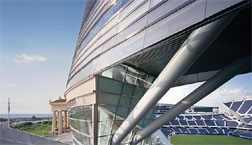 |
Two years ago, Burns’ colleagues in the Washington, D.C., office of Thornton- Tomasetti started using a newer version of XSteel, Tekla Structures, on the D.C. Major League Baseball Park. It has been a completely different ball game as the designbuild contractor embraced the model. “The market has completely changed,” says Burns, a managing principal in TT’s Chicago office. “There’s more acceptance,” not just in the contracting community but in the design and development communities. Software is now more user-friendly and interoperable with other modeling programs.
|
To create the model, the engineer relies on the architect defining elements earlier. For Soldier Field, that was like pulling teeth. On the D.C. ballpark, architect HOK/Devrouax- Purnell, was able to adjust its process to lock in the geometry six months sooner than usual. “It was an excellent opportunity,” says Versie Stephenson, the architect’s structural coordinator, in HOK Sport Venue Entertainment’s Kansas City office.
"Soldier Field was a tough sell,” says Burns. For the D.C. ballpark, it was almost a given that TT would model the steel in 3D.
even years ago, structural engineer Joseph G. Burns used XSteel, 3D solidobject modeling software for steel frames, on a sports facility, Chicago’s Soldier Field. He was way ahead of the game and he got singed. The design-build contractor was extremely resistant to the paradigm shift, the architect struggled with it and the tumult was palpable. Related Links:
Related Links: 
Post a comment to this article
Report Abusive Comment